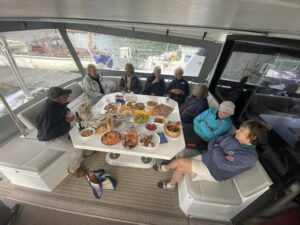Be very careful about inviting a single-hander onto your boat – they’ll drink all your gin, and then you have to throw them over the side to get rid of them.
I grew up with this – it was my parents’ philosophy whenever a scruffy old boat ghosted into the anchorage with a single, scruffy old man at the helm.
Of course, now I recognise myself in the role – and so, I am rather reticent when it comes to social life.
But last weekend was uncharacteristically convivial. It was the Ocean Cruising Club’s West Country Meet.
This opens with a formal dinner at the Royal Cornwall in Falmouth – loyal toasts and whatnot (I passed the port the wrong way).

Of course, this meant it came back to me with some left, and so it was a slightly unsteady old man who manhandled his dinghy over the side of the club slip and rowed back the half mile or so wearing a Laser sailor’s buoyancy aid and two head torches – one facing forward, one aft (I only had the aft one turned on – the for’ard light is for emergencies only – otherwise, I have no night vision at all.)
But the high point of the weekend is the raft-up on the pontoon up the river at Ruan. An advance party stakes our claim and erects the gazebo (how many ocean sailors does it take to erect a gazebo?)
By six o’clock, there were some 30 people cowering under this thing as the rain dripped down the necks of those in the back row. Never mind, the sausage rolls stayed dry. It was only going to be a matter of time before we had to decamp to somebody’s boat – but even the biggest – a beautiful 44footer – could never accommodate thirty people in soggy Mustos.
“What we need,” people started to say, “is That…”
“That” was a Leopard 50 catamaran towering over all the other occupants. The top deck (of three) reached practically to Samsara’s crosstrees.
And then – would you believe it – the crew of the Leopard turned out to be members too. They had sailed from Cape Town but had no idea about any West Country Meet – and of course, they would be delighted to welcome 30 rather damp fellow members and their sausage rolls.
Within five minutes, we were all settled in the Leopard’s two dining areas (well, actually, there are three, but the top deck is really only for tropical evenings). I thought it was more fun than the formal dinner.

Also, I learned a thing or two about enormous catamarans and the people who sail them.
Yes, there was an ice maker.
And next to it, a Sodastream.
Next to the Sodastream was a coffee machine.
Next to the coffee machine (with milk-frother) was the airfryer…
And yet, the owners were a very down-to-earth family without any of the airs and graces you associate with superyachts. They just happened to have worked all their lives in the Middle East with no income tax and an evidently good accountant.
It was the following morning, after most of the other boats had left to beat the tide back to Falmouth and as I was depositing the gash (how many pontoons have a gash-bin?) that the Leopard skipper invited me aboard again for a coffee.
Now, as we know, this can be dangerous – even at that time of the morning. But what I hadn’t realised was that this time, it was me on the wrong end of the “Mad Old Singlehander” dilemma.
Somehow the skipper had got it into his head that Samsara would be the perfect boat for his university-student son to get some real boot-strap sea time. Would I take the lad to Jersey with me?
This was a difficult one. How could I say No without giving offence – especially after all that hospitality (the Leopard seemed to come with an extensive wine cellar – well, it was extensive before we got started on it.)
I protested that my liferaft was out of date and please don’t ask about the flares…
I complained that I was no good at giving orders (they never made me a prefect at school).
Basically, I have been on my own now for so long that I have acquired an absolute horror at the prospect of crew.
The university student seemed to realise this long before his father. He began to edge back towards his cabin (stateroom).
I think it was the lack of an EPIRB that did it in the end.*
All the same, we parted on the best of terms, and I am writing this in St Helier after a delightful passage with a full moon, a following wind and a flat sea – ultimately catching the tide perfectly off La Corbière.
Yet, even then, it never occurred to me that this might be a moment to share. Instead, I hugged it to myself and opened a solitary beer – just the one…
- Please don’t post outraged comments about the irresponsibility of not carrying an EPIRB. It’s all explained in Chapter Six of Old Man Sailing.

U haven’t navigated until you have used an old sock on a piece of string and a watch as log plus the Townsend ferry or an RAF airways chart for plotting!
Yes! Navionics is our beacon today too!!
We used to have only a compass our walker log and seafahrer dept indicator
Than rhe Seafix wich was better than the.transistor radio with a long wave functon but we never got a proper position from it. It was nice for homing on a beacon but that was all.
The Seafix got me into Falmouth once – thick fog and a flat calm, sitting on the forehatch (away from the engine interference) taking running fixes.